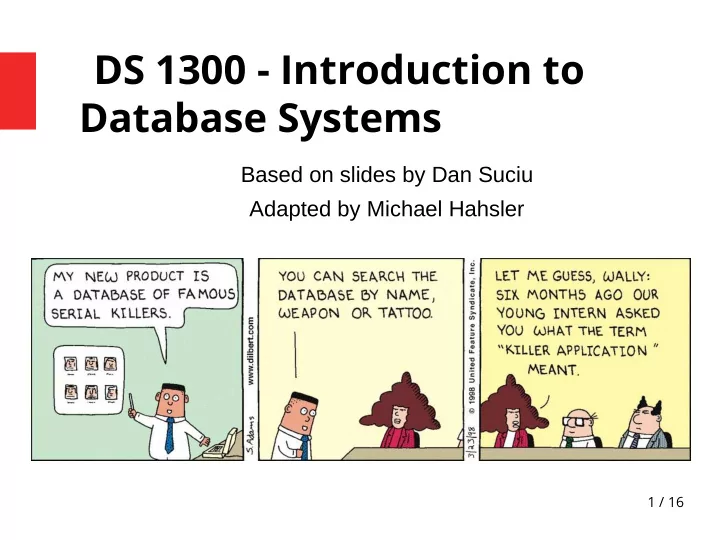

DS 1300 - Introduction to Database Systems Based on slides by Dan Suciu Adapted by Michael Hahsler 1 / 16
Database What is a database? Physical storage: A collection of fjles storing related ● data. Logical: A collection of tables (or objects). ● Examples of databases Accounts database; payroll database; SMU’s students ● database; Amazon’s products database; airline reservation database. 2 / 16
Database Management System What is a DBMS? ● A complicated (and often expensive) piece of software typically running on a large (remote) server written by someone else that allows us to manage effjciently a large database and allows it to persist over long periods of time. Examples of DBMS ● Commercial: DB2 (IBM), SQL Server (MS), Oracle, Sybase ● Open Source: MySQL, Postgres, SQLite, … ● Big Data: often NoSQL like MongoDB, Apache Cassandra, etc. 3 / 16
Architecture: Using a DMBS “Client-server Architecture” connection (ODBC, JDBC) Database server Applications Data files running the DBMS running a client 4 / 16
Operations: Query/Update Assume we have a database for movies and actors. Simple query: ● – In what year was ‘Star Wars’ produced? Multi-table query: Movies Actors ● – Find all movies with ‘Harrison Ford’ (combine actor and movie tables) Complex query: ● – For each actor, count her/his movies Updating ● – Insert a new movie; add an actor to a movie; etc 5 / 16
Operations: Query/Update ● Files ( e.g., CSV) Simple queries Multi-table queries ● Spreadsheets (maybe) All ● DBMS Updates: generally OK 6 / 16
Change the Structure of a DB Add Address to each Actor Very hard Files ( e.g., CSV) ● Yes Spreadsheets ● Yes DBMS ● 7 / 16
Issue: Concurrent Access Multiple users access/update the data concurrently ● What can go wrong? – Lost update; resulting in inconsistent data ● How do we protect against that in OS? – Locks ● Databases need a similar concept to deal with concurrent updates. 8 / 16
Issue: Recover from crashes Transfer $100 from account #4662 to #7199: ● X = Read(Accounts, 4662); X = Read(Accounts, 4662); X.amount = X.amount - 100; X.amount = X.amount - 100; Write(Accounts, 4662, X); Write(Accounts, 4662, X); CRASH ! Y = Read(Accounts, 7199); Y = Read(Accounts, 7199); Y.amount = Y.amount + 100; Y.amount = Y.amount + 100; Write(Accounts, 7199, Y); Write(Accounts, 7199, Y); 9 / 16 What is the problem ?
Concurrency & Recovery: Transactions A transaction = sequence of statements that either all ● succeed, or all fail together. E.g., Transfer $100 ● BEGIN TRANSACTION ; BEGIN TRANSACTION ; UPDATE Accounts UPDATE Accounts SET amount = amount - 100 SET amount = amount - 100 WHERE number = 4662 WHERE number = 4662 UPDATE Accounts UPDATE Accounts SET amount = amount + 100 SET amount = amount + 100 WHERE number = 7199 WHERE number = 7199 COMMIT COMMIT 10 / 16
Transactions Transactions have the ACID properties: All or nothing A = atomicity Valid state to valid state C = consistency Transactions are independent I = isolation D = durability No data loss after commit Transactions also allow rollbacks (undo). 11 / 16
Relational Data Base = Collection of Tables Actors: Movie_Actors: id fName lName id mid 15901 Harrison Ford 15901 130128 . . . . . . Movies: mid Title Year 130128 Star Wars 1977 . . . 12 / 16
Create/Store Large Datasets Use SQL to create and populate tables: CREATE TABLE Actors ( CREATE TABLE Actors ( INSERT INTO Actors fName CHAR(30), INSERT INTO Actors fName CHAR(30), VALUES('Harrison', 'Ford', . . .) lName CHAR(30), VALUES('Harrison', 'Ford', . . .) lName CHAR(30), . . . ) . . . ) Physical organization of the data is handled by DBMS We focus on modeling the database! 13 / 16
Querying ● Find all movies with ‘Harrison Ford’ SELECT title SELECT title FROM Movies, Actors, Movie_Actors FROM Movies, Actors, Movie_Actors WHERE Actors.lname = ‘Ford’ and WHERE Actors.lname = ‘Ford’ and Actors.fname = ‘Harrison’ and Actors.fname = ‘Harrison’ and Movies.mid = Movie_Actors.mid and Movies.mid = Movie_Actors.mid and Movie_Actors.id = Actors.id Movie_Actors.id = Actors.id ● What happens behind the scene ? – The DBMS uses indices and optimizes automatically the query... 14 / 16
Change the Structure of a Table Add Address to each Actor ALTER TABLE Actor ALTER TABLE Actor ADD address CHAR(50) ADD address CHAR(50) DEFAULT ‘unknown’ DEFAULT ‘unknown’ 15 / 16
What comes next? 1) Using a DBMS 2) Using SQL to Query Databases 3) Designing a Database 16 / 16
Recommend
More recommend